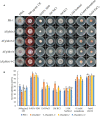FgMet3 and FgMet14 related to cysteine and methionine biosynthesis regulate vegetative growth, sexual reproduction, pathogenicity, and sensitivity to fungicides in Fusarium graminearum
- PMID: 36352883
- PMCID: PMC9638117
- DOI: 10.3389/fpls.2022.1011709
FgMet3 and FgMet14 related to cysteine and methionine biosynthesis regulate vegetative growth, sexual reproduction, pathogenicity, and sensitivity to fungicides in Fusarium graminearum
Abstract
Fusarium graminearum is a destructive filamentous fungus, which widely exists in wheat and other cereal crops. Cysteine and Methionine are unique sulfur-containing amino acids that play an essential role in protein synthesis and cell life, but their functions and regulation in F. graminearum remain largely unknown. Here we identified two proteins, FgMet3 and FgMet14 in F. graminearum, which are related to the synthesis of cysteine and methionine. We found FgMet3 and FgMet14 were localized to the cytoplasm and there was an interaction between them. FgMet3 or FgMet14 deletion mutants (ΔFgMet3 and ΔFgMet14) were deficient in vegetative growth, pigment formation, sexual development, penetrability and pathogenicity. With exogenous addition of cysteine and methionine, the vegetative growth and penetrability could be completely restored in ΔFgMet3 and ΔFgMet14, while sexual reproduction could be fully restored in ΔFgMet3 and partially restored in ΔFgMet14. ΔFgMet3 and ΔFgMet14 exhibited decreased sensitivity to Congo red stress and increased sensitivity to SDS, NaCl, KCl, Sorbitol, Menadione, and Zn ion stresses. Moreover, FgMet3 and FgMet14 nonspecifically regulate the sensitivity of F. graminearum to fungicides. In conclusion, FgMet3 and FgMet14 interacted to jointly regulate the development, pathogenicity, pigment formation, sensitivity to fungicides and stress factors in F. graminearum.
Keywords: FgMet14; FgMet3; cysteine; fungicide sensitivity; fusarium graminearum; methionine; pathogenicity; sexual reproduction.
Copyright © 2022 Zhao, Yuan, Wen, Huang, Mao, Zhou and Hou.
Conflict of interest statement
The authors declare that the research was conducted in the absence of any commercial or financial relationships that could be construed as a potential conflict of interest.
Figures












Similar articles
-
The plasma membrane H+ -ATPase FgPMA1 regulates the development, pathogenicity, and phenamacril sensitivity of Fusarium graminearum by interacting with FgMyo-5 and FgBmh2.Mol Plant Pathol. 2022 Apr;23(4):489-502. doi: 10.1111/mpp.13173. Epub 2021 Dec 17. Mol Plant Pathol. 2022. PMID: 34921490 Free PMC article.
-
FgAP1σ Is Critical for Vegetative Growth, Conidiation, Virulence, and DON Biosynthesis in Fusarium graminearum.J Fungi (Basel). 2023 Jan 21;9(2):145. doi: 10.3390/jof9020145. J Fungi (Basel). 2023. PMID: 36836259 Free PMC article.
-
Genome-Wide Characterization of PX Domain-Containing Proteins Involved in Membrane Trafficking-Dependent Growth and Pathogenicity of Fusarium graminearum.mBio. 2021 Dec 21;12(6):e0232421. doi: 10.1128/mBio.02324-21. Epub 2021 Dec 21. mBio. 2021. PMID: 34933449 Free PMC article.
-
Recent advances in genes involved in secondary metabolite synthesis, hyphal development, energy metabolism and pathogenicity in Fusarium graminearum (teleomorph Gibberella zeae).Biotechnol Adv. 2014 Mar-Apr;32(2):390-402. doi: 10.1016/j.biotechadv.2013.12.007. Epub 2014 Jan 2. Biotechnol Adv. 2014. PMID: 24389085 Review.
-
NADPH Oxidase Gene, FgNoxD, Plays a Critical Role in Development and Virulence in Fusarium graminearum.Front Microbiol. 2022 Mar 3;13:822682. doi: 10.3389/fmicb.2022.822682. eCollection 2022. Front Microbiol. 2022. PMID: 35308369 Free PMC article. Review.
Cited by
-
Advances in Understanding Fusarium graminearum: Genes Involved in the Regulation of Sexual Development, Pathogenesis, and Deoxynivalenol Biosynthesis.Genes (Basel). 2024 Apr 9;15(4):475. doi: 10.3390/genes15040475. Genes (Basel). 2024. PMID: 38674409 Free PMC article. Review.
-
Genome sequencing of a novel Verticillium dahliae strain (huangweibingjun).Sci Rep. 2025 Apr 30;15(1):15143. doi: 10.1038/s41598-025-99279-z. Sci Rep. 2025. PMID: 40307341 Free PMC article.
-
FgPfn participates in vegetative growth, sexual reproduction, pathogenicity, and fungicides sensitivity via affecting both microtubules and actin in the filamentous fungus Fusarium graminearum.PLoS Pathog. 2024 May 3;20(5):e1012215. doi: 10.1371/journal.ppat.1012215. eCollection 2024 May. PLoS Pathog. 2024. PMID: 38701108 Free PMC article.
-
Transcription Activator FgDDT Interacts With FgISW1 to Regulate Fungal Development and Pathogenicity in the Global Pathogen Fusarium graminearum.Mol Plant Pathol. 2025 Apr;26(4):e70076. doi: 10.1111/mpp.70076. Mol Plant Pathol. 2025. PMID: 40151047 Free PMC article.
-
Update on the Basic Understanding of Fusarium graminearum Virulence Factors in Common Wheat Research.Plants (Basel). 2024 Apr 22;13(8):1159. doi: 10.3390/plants13081159. Plants (Basel). 2024. PMID: 38674569 Free PMC article. Review.
References
-
- Becher R., Hettwer U., Karlovsky P., Deising H. B., Wirsel S. G. R. (2010). Adaptation of fusarium graminearum to tebuconazole yielded descendants diverging for levels of fitness, fungicide resistance, virulence, and mycotoxin production. Phytopathology 100, 444–453. doi: 10.1094/PHYTO-100-5-0444 - DOI - PubMed
-
- Bechtel D. B., Kaleikau L. A., Gaines R. L., Seitz L. M. (1985). The effects of Fusarium-graminearum infection on wheat kernels. Cereal Chem. 62, 191–197.
-
- Catanesi M., Brandolini L., d'Angelo M., Benedetti E., Tupone M. G., Alfonsetti M., et al. . (2021). L-methionine protects against oxidative stress and mitochondrial dysfunction in an in vitro model of parkinson's disease. Antioxidants-Basel 10 (9), 1467. doi: 10.3390/antiox10091467 - DOI - PMC - PubMed
LinkOut - more resources
Full Text Sources

